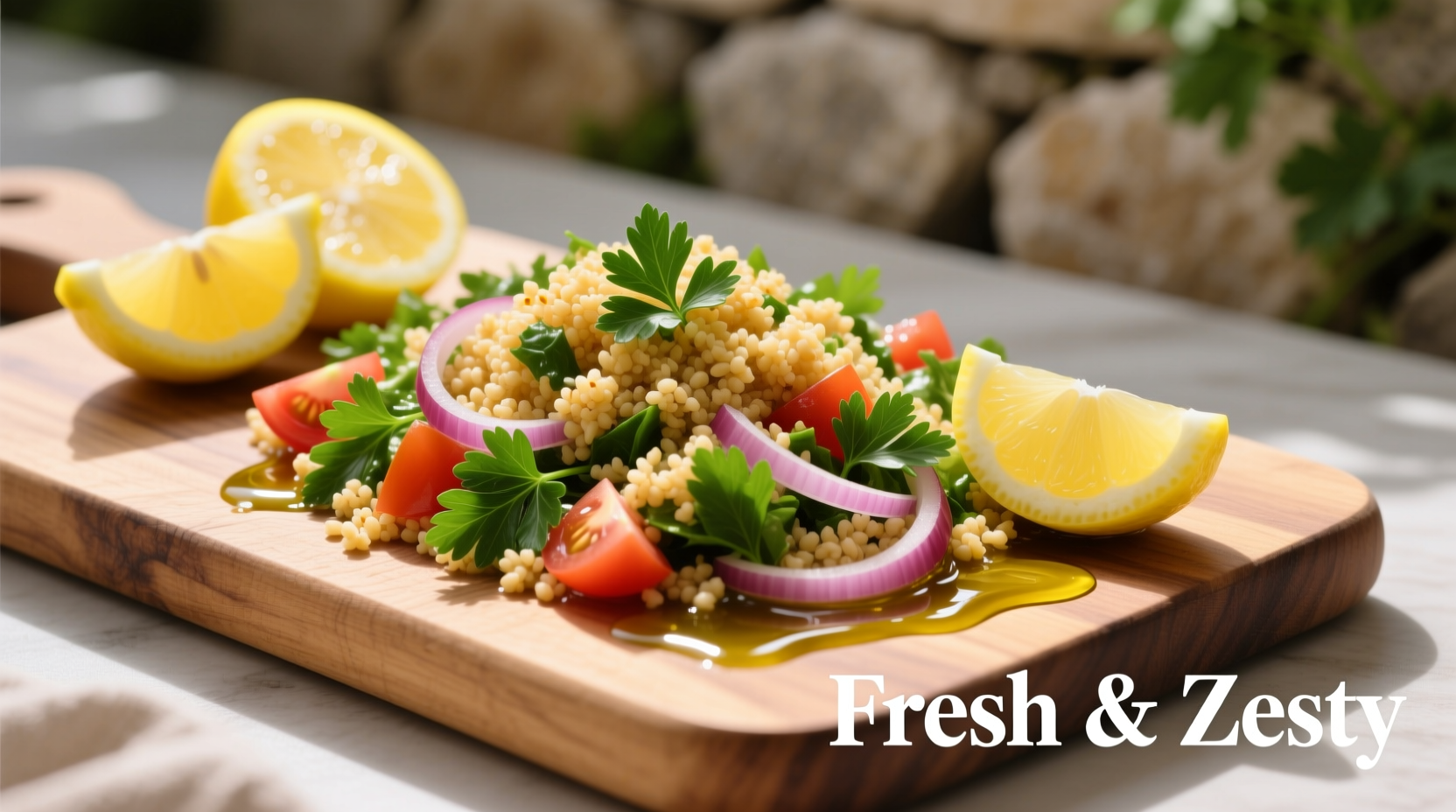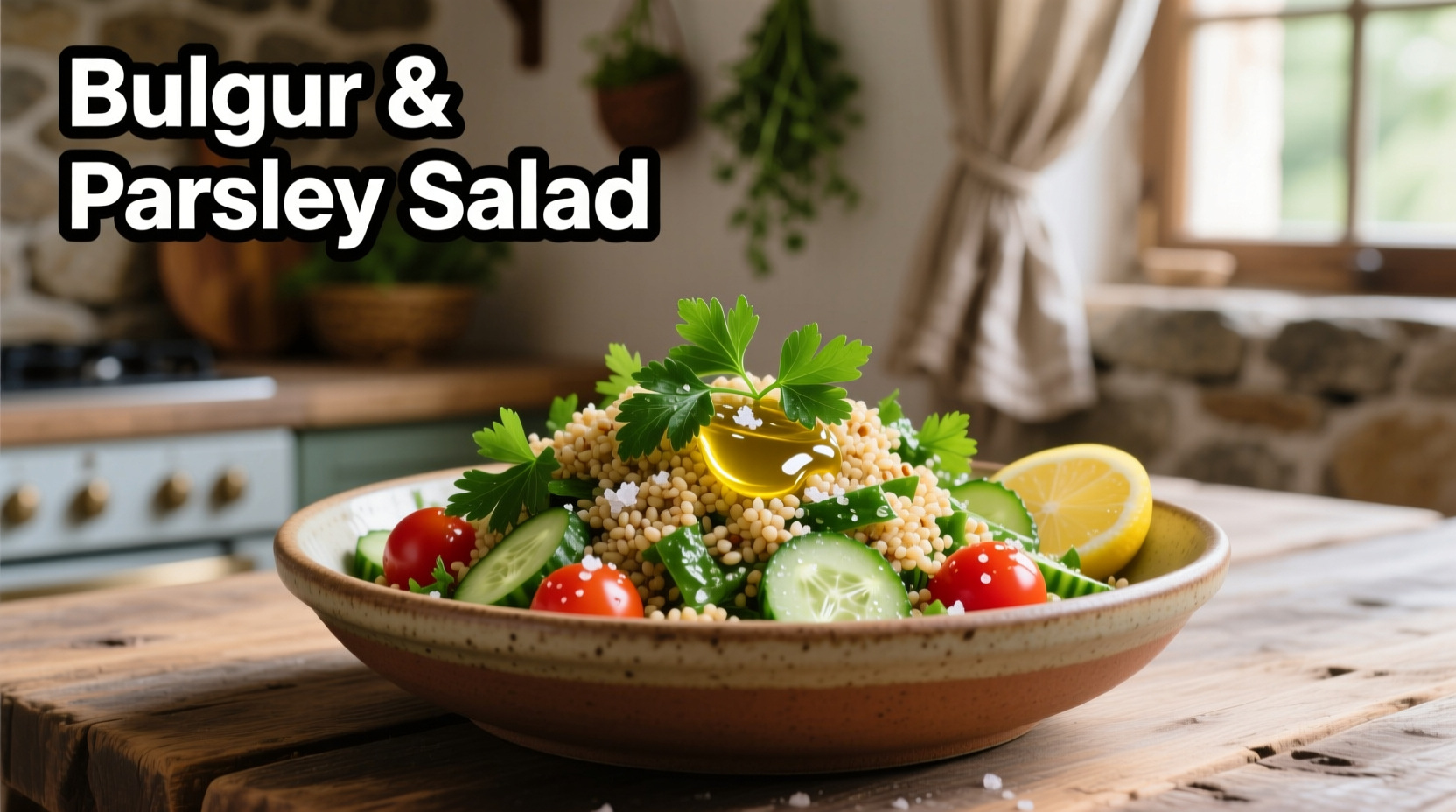Forget everything you thought you knew about grain salads. This vibrant bulgur and parsley salad—properly called tabbouleh in its authentic form—transcends ordinary side dishes with its herb-forward profile and satisfying texture. Unlike Western interpretations that overemphasize bulgur, traditional preparation features parsley as the star ingredient, creating a light, refreshing experience perfect for warm weather dining.
Why This Salad Belongs in Your Recipe Rotation
Food historians trace tabbouleh's origins to the Levant region, where it evolved as a practical way to utilize abundant fresh herbs and seasonal vegetables. Modern nutrition research confirms what Middle Eastern cultures have known for centuries: this salad delivers remarkable health benefits. According to USDA FoodData Central, a single serving provides 100% of your daily vitamin K needs and significant amounts of vitamins A and C.
| Traditional Preparation | Common Western Adaptation | Nutritional Impact |
|---|---|---|
| 75% parsley, 25% bulgur | 50% bulgur, 50% herbs | Traditional version has 40% more vitamin C |
| Hand-chopped ingredients | Food processor blending | Hand-prepared maintains better texture and flavor release |
| Fresh-squeezed lemon dressing | Vinegar-based dressing | Lemon enhances iron absorption from parsley |
Essential Ingredients Breakdown
The magic of authentic bulgur and parsley salad lies in ingredient quality and proper ratios. Don't substitute dried parsley—fresh flat-leaf variety provides the distinctive grassy flavor that defines this dish. For the bulgur, choose fine #1 grind which absorbs liquid perfectly without becoming mushy.
When selecting ingredients, follow this professional chef guideline: the parsley-to-bulgur ratio should be 3:1. This maintains the traditional herb-forward profile rather than turning into a grain-heavy dish. The tomatoes should be ripe but firm, and mint should be used sparingly to complement rather than dominate.

Step-by-Step Preparation Guide
Mastering authentic tabbouleh requires attention to technique, not complexity. Follow these steps for restaurant-quality results:
- Prepare the bulgur: Place 1/2 cup fine bulgur in a heatproof bowl. Pour 3/4 cup boiling water over it, cover, and let sit for 15 minutes until water is absorbed. Fluff with fork and cool completely.
- Chop ingredients properly: Using a sharp knife (not a food processor), finely chop 2 cups packed flat-leaf parsley and 1/4 cup fresh mint. Dice 1 cup ripe tomatoes into 1/8-inch pieces.
- Create the dressing: Whisk together 1/4 cup fresh lemon juice, 1/3 cup extra-virgin olive oil, 1 minced garlic clove, and 1/2 teaspoon sea salt.
- Combine ingredients: In a large bowl, mix cooled bulgur, chopped herbs, tomatoes, and dressing. Gently fold to avoid bruising the herbs.
- Rest before serving: Cover and refrigerate for at least 1 hour (up to 4 hours) to allow flavors to meld. Stir gently before serving.
Pro Tips for Perfect Results
Professional chefs emphasize these critical details that separate good tabbouleh from exceptional:
- Water temperature matters: Always use boiling water for the bulgur to achieve proper texture without overcooking
- Chill ingredients: Cold ingredients prevent the salad from becoming soggy as it rests
- Timing is crucial: Don't dress the salad more than 4 hours before serving to maintain vibrant color and texture
- Salt strategically: Add half the salt initially, then adjust after resting when flavors have developed
When This Salad Shines: Context Boundaries
Understanding when bulgur and parsley salad performs best ensures optimal dining experiences:
- Perfect pairing: Serves as an ideal accompaniment to grilled meats, especially lamb and chicken, balancing rich flavors with its brightness
- Seasonal suitability: Performs best with summer produce when tomatoes and herbs reach peak flavor (May-September in Northern Hemisphere)
- Meal context: Functions as a refreshing side for heavy meals but lacks sufficient protein to serve as a standalone main dish
- Storage limitations: Best consumed within 24 hours as prolonged storage causes herbs to darken and texture to degrade
Serving Suggestions and Variations
Elevate your bulgur and parsley salad experience with these authentic presentation techniques:
- Serve in crisp lettuce cups for a gluten-free presentation that enhances the fresh flavor profile
- Garnish with pomegranate seeds for added color contrast and complementary sweet-tart flavor
- Pair with grilled halloumi cheese for a satisfying vegetarian meal option
- Add toasted pine nuts just before serving for contrasting texture
For those exploring authentic regional variations, Lebanese tabbouleh features more mint and less tomato than Syrian versions, while Palestinian preparations often include finely diced cucumber for additional crunch.
Storage and Meal Prep Guidance
While best served fresh, proper storage techniques can extend enjoyment:
- Store in an airtight container with parchment paper pressed directly onto the salad surface to prevent oxidation
- Keep dressing components separate until ready to serve for maximum freshness
- Revive day-old salad with a squeeze of fresh lemon juice and additional chopped parsley
- Freezing is not recommended as it destroys the delicate herb texture
Frequently Asked Questions
Can I make bulgur and parsley salad gluten-free?
Yes, authentic tabbouleh using fine #1 bulgur is naturally gluten-free as bulgur wheat is processed differently than regular wheat. For strict gluten-free requirements, substitute with quinoa prepared using the same method.
Why is my bulgur and parsley salad watery?
Excess moisture typically comes from tomatoes with high water content. To prevent this, remove tomato seeds and pulp before dicing, and let chopped tomatoes drain in a colander for 10 minutes before adding to the salad.
How long does homemade bulgur salad last in the refrigerator?
Properly stored in an airtight container with parchment paper pressed on the surface, authentic bulgur and parsley salad maintains optimal quality for 24-36 hours. Beyond this timeframe, the herbs darken and texture deteriorates significantly.
What's the difference between tabbouleh and regular bulgur salad?
Traditional tabbouleh features parsley as the primary ingredient (75% of the mix) with bulgur as a supporting component, while Western 'bulgur salads' typically reverse this ratio. Authentic preparation also requires hand-chopping rather than food processing to maintain proper texture.











 浙公网安备
33010002000092号
浙公网安备
33010002000092号 浙B2-20120091-4
浙B2-20120091-4